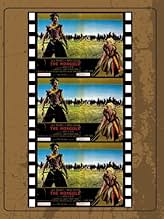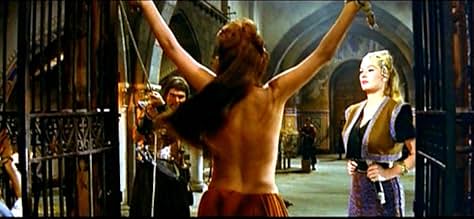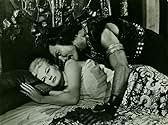Ajouter une intrigue dans votre langueDuring the Mongol invasion of Poland, a conflict between Mongol Emperor Genghis Khan and his oldest son Ogotai ensues when the former aims for peace and the latter itches for war and conques... Tout lireDuring the Mongol invasion of Poland, a conflict between Mongol Emperor Genghis Khan and his oldest son Ogotai ensues when the former aims for peace and the latter itches for war and conquest.During the Mongol invasion of Poland, a conflict between Mongol Emperor Genghis Khan and his oldest son Ogotai ensues when the former aims for peace and the latter itches for war and conquest.
- Réalisation
- Scénario
- Casting principal
Lawrence Montaigne
- L'aleato di Stefano
- (as Lawrenc Montaigne)
Mario Colli
- Boris
- (non crédité)
Andrej Gardenin
- Fencer
- (non crédité)
Janine Hendy
- La danzatrice nell'harem
- (non crédité)
Avis à la une
I've wanted to watch this movie for a long time based on the performance of Jack Palance in a previous role as Atilla in "Sign of the Pagan". I wasn't disappointed in Palance's performance as Ogatai but as a whole this film was very inconsistent and horribly incorrect historically. To say the writers of this movie took liberties with history is an understatement. The great battle between the Mongols and the combined armies of Europe did take place, but not with the results described in the movie. In fact, the Mongols did have the opportunity to move much further westward into Europe, except by chance were diverted back home due to the death of the emperor and than later resumed their campaign toward the south/west and the Middle East, considered more attractive at this time in history. The movie does have some lavish costumes and epic battles, but it also often repeats the same footage over and over again. This movie actually had some potential with the amount of money it seemed to have in its production, but somebody dropped the ball in terms of editing, music and story. Blond haired Anita Ekberg as Ogatai's lover at first glance seems absurd, but plausible when you consider that the Mongols conquered all of Asia and most of Eastern Europe. Her acting is actually fairly good. The movie is worth seeing if your a fan of Jack Palance, his character of Ogatai is a unique one.
When Jack Palance signed on to do The Mongols an Italian produced epic shot in Yugoslavia he merely took out his former performance of as Attila The Hun ratcheted it up exponentially. When you're in a turkey like this all you can do is gobble gobble at the moon.
The only names we Americans will recognize are that of Palance playing Ogatai son of Genghis Khan and his lovely blond amazon wife played by Anita Ekberg. I will say this the writers did make provision for the fact that she clearly does not look like a Mongol and did mention that she was from a captive people. Perhaps a Viking settlement somewhere in Eastern Europe might explain it. I'll say this with that massive endowment of her's Anita looks good even in that Mongol armor. One fill figured girl she was.
When Palance is on there isn't a stick of furniture left standing. He is having one great old time overacting against the background of these continental cast members who sound stiff as usual with their dubbed voices. The Europeans have decided to sue for peace and have sent the film's nominal hero Franco Silva playing Stephen of Cracow as a peace emissary.
But Palance really gets his jollies with all the blood and guts and he doesn't want to stop the fighting. In this he's aided and abetted by Anita. So nice when husband and wife have a mutual interest. He and Anita do what they can to sabotage a cease fire.
In the end it's pulled out and western civilization itself is saved by a seasoned soldier taking home town advantage of the elements.
Jack Palance fans should get a real charge out of this film watching their guy dine on the scenery. The Mongols will give you quite a few unintentional laughs.
The only names we Americans will recognize are that of Palance playing Ogatai son of Genghis Khan and his lovely blond amazon wife played by Anita Ekberg. I will say this the writers did make provision for the fact that she clearly does not look like a Mongol and did mention that she was from a captive people. Perhaps a Viking settlement somewhere in Eastern Europe might explain it. I'll say this with that massive endowment of her's Anita looks good even in that Mongol armor. One fill figured girl she was.
When Palance is on there isn't a stick of furniture left standing. He is having one great old time overacting against the background of these continental cast members who sound stiff as usual with their dubbed voices. The Europeans have decided to sue for peace and have sent the film's nominal hero Franco Silva playing Stephen of Cracow as a peace emissary.
But Palance really gets his jollies with all the blood and guts and he doesn't want to stop the fighting. In this he's aided and abetted by Anita. So nice when husband and wife have a mutual interest. He and Anita do what they can to sabotage a cease fire.
In the end it's pulled out and western civilization itself is saved by a seasoned soldier taking home town advantage of the elements.
Jack Palance fans should get a real charge out of this film watching their guy dine on the scenery. The Mongols will give you quite a few unintentional laughs.
This was one of a number of low-brow peplums about ancient warrior tribes made in the wake of THE VIKINGS (1958) – this one even boasted a similarly rousing score by that film’s same composer, Mario Nascimbene. Others in this vein included THE COSSACKS (1960), THE TARTARS (1961) and ATTACK OF THE NORMANS (1962) – the latter being the only one in the bunch that I’ve watched, though I did lose the first one a couple of times on Italian TV.
Actually, this one turned out to be pretty good – and, I have to say, it lived up to the review on “Stracult” where special reference is made to its sequences of bloodthirsty action and sadism. Jack Palance gives the role of Ogotai – son of Asian potentate Genghis Khan – his eye-rolling all; he’s abetted by an equally evil Anita Ekberg (the mighty but battle-weary Khan himself perishes by her hand!). The unhistorical narrative involves the Mongols’ raid of Poland and, in particular, the attempts by one of the latter’s leading figures (Franco Silva) to negotiate a peace treaty with the Khan – a plan which Palance vehemently opposes and constantly schemes to thwart.
Being a relatively low-budget effort, the triple directorial credit might seem surprising: however, as the Italian credits themselves clearly indicate, this translates to being “A Film by Andre' De Toth” (implying that he was merely engaged in a supervisory capacity), “Directed by Leopoldo Savona”, and “Battle Sequences Staged by Riccardo Freda”. With this in mind, there are fewer of the latter than one would perhaps have appreciated – but these are nonetheless handled with the requisite gusto and grandeur. The rest of the film is largely taken up by various court intrigues on both sides of the fence but also a three-way Polish romance involving the aforementioned Franco Silva, Antonella Lualdi and Pierre Cressoy that tends to swamp Palance’s troubled relationship with his own wife!
As I said, the violence is really at the fore in this film – the Mongols themselves are memorably introduced on horseback dragging a statue of the Virgin Mary through the streets of a Polish city they’d just ransacked; besides, there are plenty of floggings (Ekberg herself lends a hand in the punishment of the perennially imperiled Lualdi), crucifixions (two men are even tied to the wheels of an advancing cart!), burnings at the stakes, etc. The finale, then, sees an Alexander NEVSKY (1938)-type strategy at work with the apparently fleeing Silva and his men luring the pursuing Mongol forces into a deadly swamp. The film was good enough almost to merit a *** rating from me…but, at 115 minutes, it’s quite a long haul – especially since it resorts too often to contrived (and repetitive) plotting.
Actually, this one turned out to be pretty good – and, I have to say, it lived up to the review on “Stracult” where special reference is made to its sequences of bloodthirsty action and sadism. Jack Palance gives the role of Ogotai – son of Asian potentate Genghis Khan – his eye-rolling all; he’s abetted by an equally evil Anita Ekberg (the mighty but battle-weary Khan himself perishes by her hand!). The unhistorical narrative involves the Mongols’ raid of Poland and, in particular, the attempts by one of the latter’s leading figures (Franco Silva) to negotiate a peace treaty with the Khan – a plan which Palance vehemently opposes and constantly schemes to thwart.
Being a relatively low-budget effort, the triple directorial credit might seem surprising: however, as the Italian credits themselves clearly indicate, this translates to being “A Film by Andre' De Toth” (implying that he was merely engaged in a supervisory capacity), “Directed by Leopoldo Savona”, and “Battle Sequences Staged by Riccardo Freda”. With this in mind, there are fewer of the latter than one would perhaps have appreciated – but these are nonetheless handled with the requisite gusto and grandeur. The rest of the film is largely taken up by various court intrigues on both sides of the fence but also a three-way Polish romance involving the aforementioned Franco Silva, Antonella Lualdi and Pierre Cressoy that tends to swamp Palance’s troubled relationship with his own wife!
As I said, the violence is really at the fore in this film – the Mongols themselves are memorably introduced on horseback dragging a statue of the Virgin Mary through the streets of a Polish city they’d just ransacked; besides, there are plenty of floggings (Ekberg herself lends a hand in the punishment of the perennially imperiled Lualdi), crucifixions (two men are even tied to the wheels of an advancing cart!), burnings at the stakes, etc. The finale, then, sees an Alexander NEVSKY (1938)-type strategy at work with the apparently fleeing Silva and his men luring the pursuing Mongol forces into a deadly swamp. The film was good enough almost to merit a *** rating from me…but, at 115 minutes, it’s quite a long haul – especially since it resorts too often to contrived (and repetitive) plotting.
This is a highly entertaining Italian epic -- provided that you watch it for fun and not as a history lesson. The real Genghis Khan, historians tell us, was responsible for the deaths of some 20 million people, roughly a tenth of the known world, but in this version Roldano Lupi, bewhiskered and benign, comes across as a sort of Mongolian Father Christmas. As his evil son, Ogotai, Jack Palance has the time of his life dispensing cruelties and whippings with his usual leering relish, but he also imbues his role with a certain depth of character. Palance, carrying on where his maniac charioteer in Barabbas left off, is easily the best actor on show and more than anyone else holds the film together. By contrast, his leading lady is simply hilarious. "We Mongols..." says Anita Ekberg, looking exactly like Anita Ekberg and soon to go for a nude swim in the local river shamelessly cashing in on her popular performance in La Dolce Vita where she waded into the Trevi Fountain. Her incongruous appearance is explained away by the fact that the Mongols abducted her from her homeland, but one wonders whether they acquired her from modern-day Sweden. Star Trek fans will be pleased to see Lawrence Montaigne, alias Spock's love rival Stonn, in an early role as an ally of Prince Stefan. (Italian references wrongly credit him as the King of Poland, but he's actually the one who changes clothes with Stefan to fool the Mongols). The remarkable score not too well transferred in the American prints is by film music legend Mario Nascimbene who has evidently tried to repeat the barbaric qualities of The Vikings. In his autobiography Nascimbene explains that the harsh percussion for The Mongols was achieved using ordinary household utensils. He even toured the Rome shops asking if they had a casserole dish in F-sharp or a frying pan in D-flat, and he was perhaps lucky to get out before they rang for the white coats. Back at the recording studio, conductor and friend Franco Ferrara was well accustomed to these musical eccentricities and asked if the RAI Sinfonica was always going to have a kitchens department? However, one must admit that the final score is both magnificent and ingenious. Dino Solari's choreography for the Mongol court is surprisingly erotic for its day, but disappointingly the US version has some clumsy cuts to exclude the bit where one of the male dancers gets astride and rolls round the floor with a scantily clad girl dancer. Adult ballet fans can see the uncut version on the French video release from Film Office Peplum. The battle scenes, where the Mongols are outwitted into entering a swamp where they all drown, were obviously filmed in two places. We begin in Yugoslavia where the location scenes were shot, then minutes later cut to the studio tank in Rome. Only the Italian epics can get away with this, of course, and all in all, this is a movie full of rich pickings. As long as you aren't expecting to see Henry V, it's a diverting way to spend a couple of hours.
As many other American directors, Andre De Toth finished his career in Europe; this movie seems to be a response to Richard Thorpe's THE TARTARS, produced the same year, and starring Victor Mature and Orson Welles. Rudolph Maté, Hugo Fregonese, Vincent Sherman, Edgar G Ulmer, and many other film makers finished their filmographies in Italy or Spain. This one is a pretty good one, offering splendid settings, good pace, good scenes, a gorgeous Anita Ekberg as a villainess whom you won't forget. I saw it for the first time when I was just thirteen and have never forgotten it. I like this Andre De Toth's movie.
Le saviez-vous
- AnecdotesPopularized by John Green's Crash Course YouTube series (three-second raid scene) every time he uses the phrase "The Mongols".
- GaffesDuring an invasion of the Mongols a character is seen dressed in a sleeveless jacket defending another nailed to a wheel. Ogotai (Jack Palance) drags him down with his whip, only this time the character has lost his sleeveless leather jacket, and is wearing only a wide shirt.
- ConnexionsFeatured in Crash Course: World History: The Agricultural Revolution (2012)
Meilleurs choix
Connectez-vous pour évaluer et suivre la liste de favoris afin de recevoir des recommandations personnalisées
- How long is The Mongols?Alimenté par Alexa
Détails
- Date de sortie
- Pays d’origine
- Langues
- Aussi connu sous le nom de
- The Mongols
- Lieux de tournage
- Sociétés de production
- Voir plus de crédits d'entreprise sur IMDbPro
- Durée1 heure 55 minutes
- Rapport de forme
- 2.35 : 1
Contribuer à cette page
Suggérer une modification ou ajouter du contenu manquant

Lacune principale
By what name was Les Mongols (1961) officially released in India in English?
Répondre


























